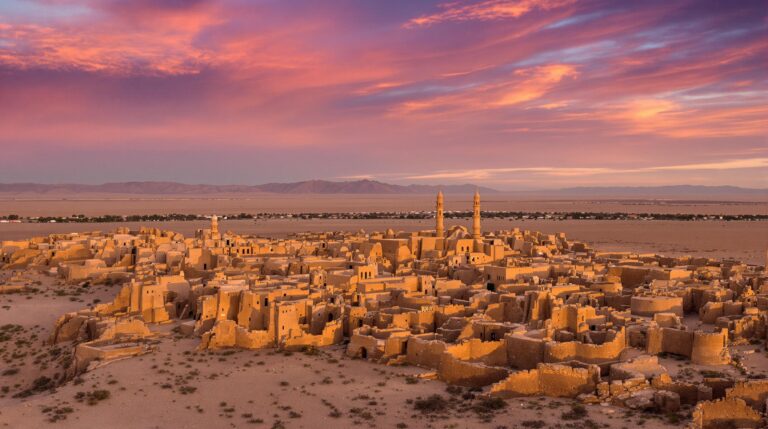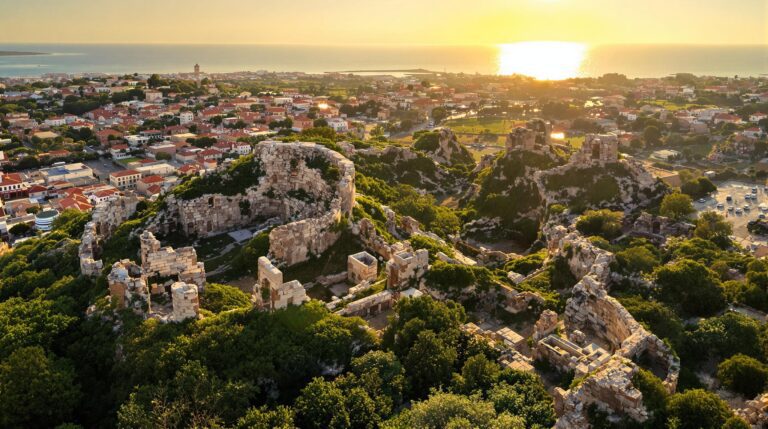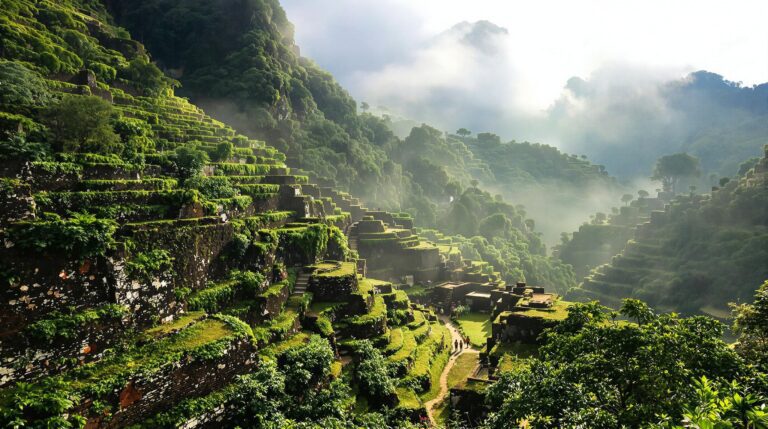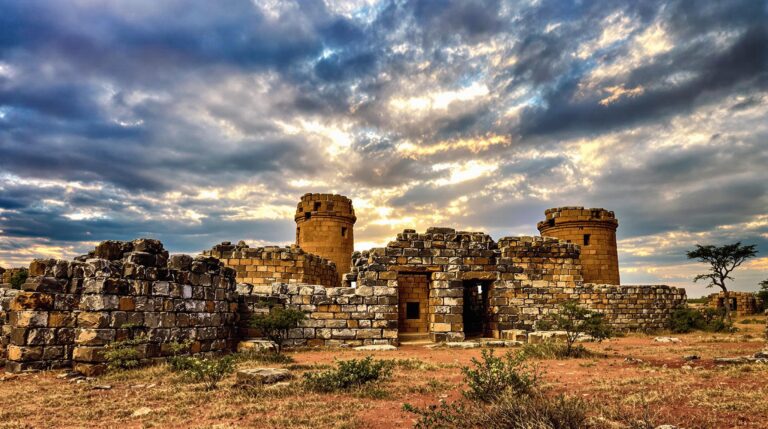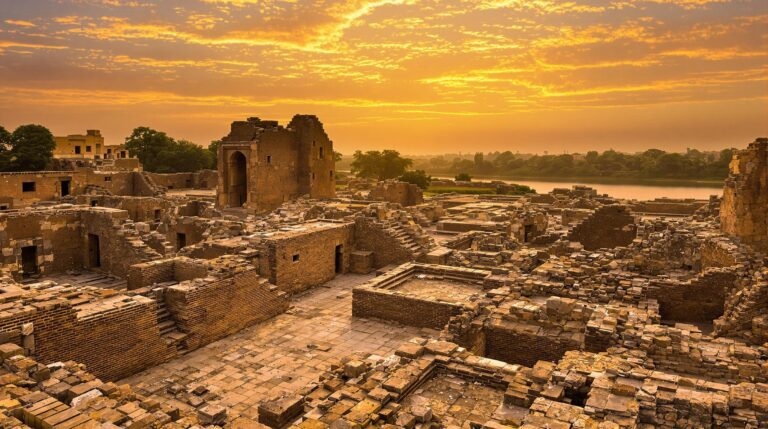Helike: Greece’s Lost City Beneath the Sea
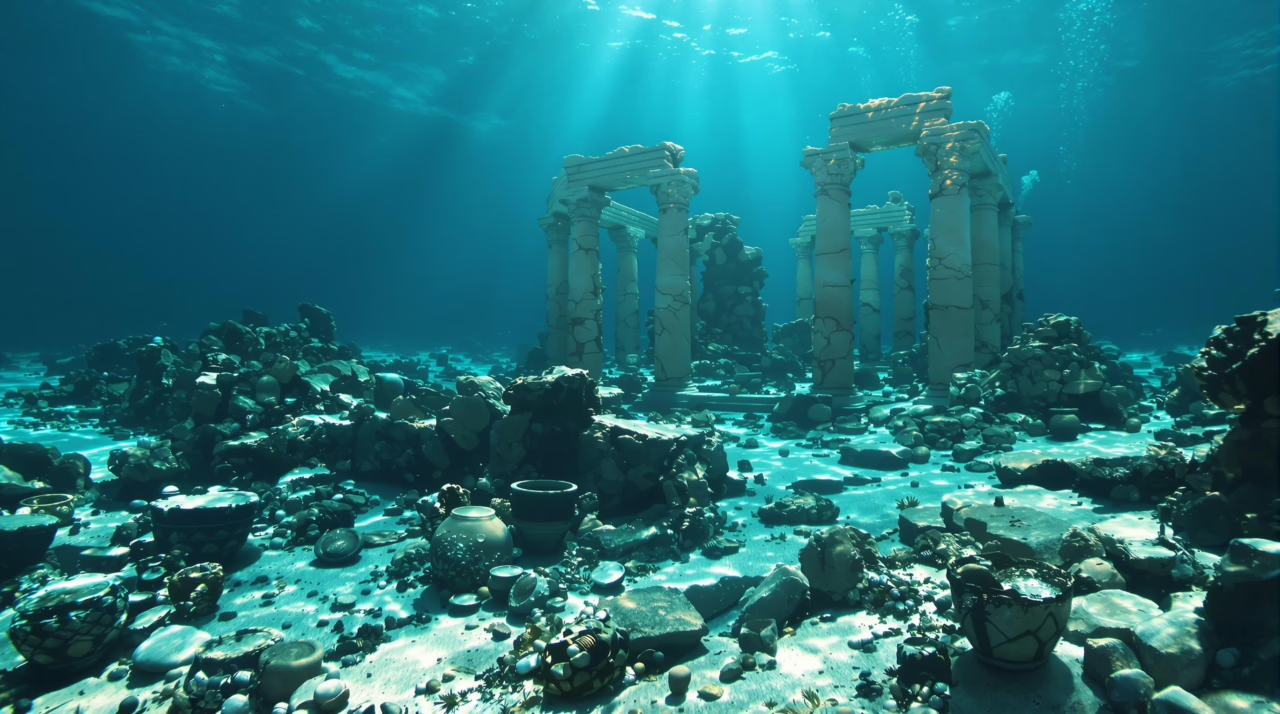
Helike’s story is one of intrigue and tragedy. This ancient city, once thriving, vanished almost overnight due to a devastating earthquake.
Its fate raises questions about human vulnerability in the face of nature’s power.
The connections to Atlantis further complicate its narrative. As recent archaeological findings emerge, one must wonder: what insights can Helike offer about resilience and the pressing challenges coastal cities face today?
Summary & Key Takeaways
Hide- Helike was an ancient Greek city known for its worship of Poseidon and strategic location along the Gulf of Corinth.
- The city was lost due to a devastating earthquake and subsequent sea rise, leading to its submersion.
- Eyewitness accounts from historical figures document Helike's cultural significance and the impact of its sudden disappearance.
- Modern archaeological discoveries have uncovered streets, pottery, and structures, revealing insights into Helike's daily life and urban organization.
- The fate of Helike serves as a cautionary tale about coastal vulnerabilities and the risks of climate change for modern urban areas.
The Ancient City That Vanished Overnight: Helike
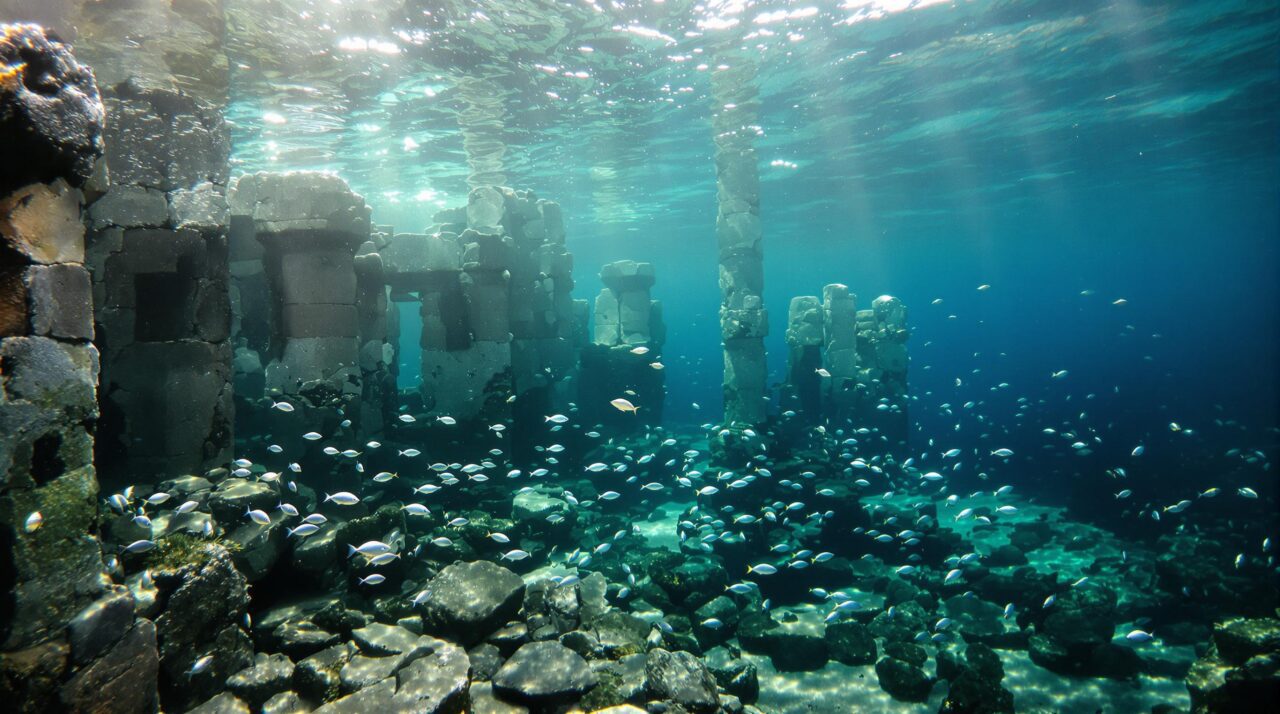
Helike, once a thriving city in ancient Greece, held significant cultural and strategic importance in the Classical world.
Its sudden disappearance, attributed to a catastrophic seismic event, invites questions about its role in the Greek socio-political landscape.
This lost city not only represents a physical absence but also a cultural void that continues to intrigue historians and archaeologists alike.
Location and Significance in the Classical World
Helike, once situated in ancient Achaea, served as a significant regional power and an essential center of worship, particularly dedicated to the sea god Poseidon.
Its strategic location along the Gulf of Corinth not only facilitated trade but also fostered cultural and religious exchanges.
The city’s sudden disappearance raises questions about its impact on the surrounding areas and the broader implications for understanding ancient Greek civilization.
Where Helike Once Stood in Ancient Achaea
Located in the region of Achaea, the ancient city of Helike was once a lively center of civilization that suddenly disappeared beneath the waves, leaving behind a tantalizing mystery for historians and archaeologists alike.
Its strategic location along the coast facilitated trade and cultural exchange, raising questions about how this thriving hub vanished so abruptly, possibly during a cataclysmic event.
Role as a Regional Power and Center of Worship
The allure of Helike lies not only in its dramatic disappearance but also in its historical significance as a regional power and a revered center of worship in the ancient world.
As a hub for the cult of Poseidon, Helike attracted pilgrims and facilitated trade, fostering cultural exchange.
Its strategic location enhanced its influence, raising questions about the dynamics of power and spirituality in ancient Greek society.
Cultural Importance in the Greek World
Helike’s cultural significance in the ancient Greek world is underscored by its prominent Sanctuary of Poseidon, which served as a religious hub for worship and pilgrimage.
Historical accounts from figures like Strabo, Pausanias, and Aelian highlight the city’s influence and the reverence it commanded in the broader Greek landscape.
This raises intriguing questions about how the sudden disappearance of Helike might have impacted religious practices and cultural narratives in the region.
Sanctuary of Poseidon and Religious Influence
Although often overshadowed by its tragic fate, the Sanctuary of Poseidon in Helike served as an essential religious and cultural hub in the ancient Greek world.
This site not only facilitated worship but also fostered community engagement, reflecting the deep interconnection between spirituality and civic life.
Its influence extended beyond mere rituals, shaping social dynamics and cultural identity among the inhabitants of Helike.
Mentions in Texts by Strabo, Pausanias, and Aelian
Ancient texts by historians such as Strabo, Pausanias, and Aelian provide invaluable insights into the cultural significance of Helike before its catastrophic demise.
These writings reveal:
- The city’s role in Greek mythology.
- Its economic prosperity and trade connections.
- The architectural grandeur of its structures.
- The profound impact of its sudden loss on surrounding regions.
Such accounts invite inquiry into Helike’s enduring legacy.
A Catastrophic End Remembered in Legend
The catastrophic demise of Helike, marked by a violent earthquake and a subsequent rise in the sea, has left an indelible mark on regional folklore.
This event not only obliterated the city but also transformed the landscape and its cultural memory, prompting inquiries into the long-lasting effects on surrounding communities.
How do such legends shape perceptions of natural disasters and their impacts on society?
The Night the Earth Shook and the Sea Rose
The harrowing accounts of those who witnessed the catastrophic events leading to Helike’s demise paint a vivid picture of chaos and destruction.
As the ground trembled violently and the sea surged ominously, the city’s fate was sealed in a matter of moments.
This sudden upheaval raises questions about the interplay between natural phenomena and the resilience of ancient societies, inviting further exploration into the implications of such a disaster.
Eyewitness Accounts of Earthquake and Tsunami
How does a single moment transform a thriving civilization into a haunting legend?
Eyewitness accounts capture the chaos of that fateful night, detailing sensations that reverberated through time.
- Shaking ground beneath their feet
- A cacophony of crashing structures
- The ominous roar of the sea
- An overwhelming sense of impending doom
These narratives evoke a shared memory, binding generations to their submerged past.
Immediate Destruction and Submersion
Amidst a serene evening, an earthquake violently shattered the tranquility of Helike, releasing a catastrophic chain of events that would lead to its swift demise.
As tremors shook the ground, the once-stable city succumbed to chaos, while towering waves surged forth, engulfing streets and homes.
This swift destruction raises questions about the interplay of nature and human existence, forever embedding Helike in the annals of history.
Long-Lasting Effects on the Region
The abandonment of Helike following its catastrophic demise left a palpable void in the region, fostering an atmosphere of fear and uncertainty among neighboring communities.
This incident, steeped in tragedy, has since been transformed into a vibrant mosaic of myths and legends that permeate Greek thought, reflecting humanity’s need to make sense of such overwhelming events.
How does the interplay between historical fact and mythologizing shape the collective memory of natural disasters in the region?
Abandonment of the Area and Spread of Fear
Fear gripped the inhabitants of the region surrounding Helike as tales of its catastrophic demise spread like wildfire, leaving a profound impact that would echo through generations.
The abandonment of the area became a glaring symbol of vulnerability, where:
- Communities fractured
- Superstitions flourished
- Economic decline ensued
- Cultural legacy faded
This pervasive dread shaped the region’s identity and influenced its future, instilling a deep-seated caution.
Mythologizing the Disaster in Greek Thought
As the echoes of Helike’s destruction reverberated through time, its story transformed into a colorful mosaic of myth and legend within Greek thought.
This catastrophic event became a potent symbol of divine retribution and human hubris, influencing cultural narratives.
The collective memory of Helike’s demise not only shaped local identity but also served as a cautionary tale, warning future generations against neglecting nature’s power.
Helike and the Atlantis Connection
The relationship between Helike and Plato’s Atlantis invites intriguing comparisons, particularly in their shared narratives of sudden destruction and loss.
Ancient texts often draw parallels between the two cities, raising questions about common cultural memories of cataclysmic events.
As scholars explore these connections, the implications for understanding both historical and mythical contexts become increasingly significant.
Plato’s Atlantis and Parallels to Helike
The parallels between Helike and Plato’s Atlantis raise intriguing questions about ancient narratives of sudden destruction and lost civilizations.
Both cities experienced catastrophic events that led to their submersion, suggesting a shared thematic resonance in their tales.
This prompts a debate on whether Helike served as a potential inspiration for the myth of Atlantis, revealing the complexities of historical memory in ancient Greece.
Similarities in Sudden Destruction and Location
Drawing intriguing parallels between Helike and Plato’s Atlantis reveals striking similarities in their fabled sudden destruction and geographical settings.
Both cities experienced catastrophic events that led to their disappearance, and their locations near water bodies suggest vulnerability to natural disasters.
Key similarities include:
- Sudden submersion
- Proximity to earthquakes
- Rich maritime culture
- Historical accounts of destruction
These factors foster ongoing debates about their connections.
Debate on Whether Helike Inspired the Myth
How might the tale of Helike have influenced the legendary account of Atlantis?
Scholars explore parallels between Helike’s sudden submersion and Plato’s narrative of a lost civilization. Both accounts feature themes of hubris, divine retribution, and cataclysmic destruction.
This raises intriguing questions about cultural memory and the interplay between historical events and myth-making, inviting further examination of how truths become legend.
Ancient Sources That Linked the Two
Ancient philosophers and historians often drew parallels between lost cities like Helike and the legendary Atlantis, suggesting a shared cultural memory of catastrophic events.
This connection raises intriguing questions about how oral traditions preserved the narratives of such disasters and their impact on collective identity.
Philosophers and Historians Reflecting on Lost Cities
The allure of lost cities captivates the imagination, sparking intrigue and speculation among philosophers and historians alike.
The connection between Helike and Atlantis invites examination of ancient narratives and their implications.
- Philosophical inquiries into the nature of truth
- Historical parallels in urban destruction
- The role of myth in cultural identity
- Lessons on hubris and fragility of civilization
Cultural Memory of Disasters in Oral Traditions
While exploring the cultural memory of disasters, one can discern striking parallels between the oral traditions surrounding Helike and those of Atlantis, as both cities evoke a shared narrative of cataclysm and loss.
These tales reflect humanity’s deep-seated fears and fascinations, prompting inquiries into the nature of civilization’s fragility and the enduring quest to reconcile memory with myth in the face of overwhelming calamity.
Rediscovering a Lost City
The quest to rediscover Helike has gained momentum through modern archaeological expeditions that employ advanced techniques and technology.
Recent excavations beneath layers of earth and silt have begun to reveal artifacts and structures that hint at the city’s once lively existence.
As researchers piece together these findings, questions arise about the implications for our understanding of ancient civilizations and their vulnerabilities to natural disasters.
Modern Archaeological Expeditions
Modern archaeological expeditions to rediscover Helike have evolved notably since the initial searches of the 19th and 20th centuries, revealing both the challenges and advancements in underwater archaeology.
The pivotal discoveries made by Greek researchers in the 1990s marked a turning point, providing essential insights into the city’s fate and its cultural significance.
This ongoing exploration raises questions about the methodologies employed and the potential for further revelations beneath the waves.
Initial Searches in the 19th and 20th Centuries
As interest in ancient civilizations surged during the 19th century, the quest to uncover Helike, the fabled lost city of Greece, ignited a series of archaeological expeditions that would shape the field.
These early efforts highlighted:
- The allure of lost cities
- The challenges of underwater archaeology
- The impact of natural disasters on civilizations
- The need for innovative excavation techniques
Each search deepened the mystery surrounding Helike.
Key Discoveries by Greek Researchers in the 1990s
Significant breakthroughs emerged in the 1990s as Greek researchers reignited the search for Helike, employing advanced technologies and methodologies that had previously been unavailable.
Underwater surveys and remote sensing tools allowed for the identification of structures and artifacts, sparking renewed interest.
These discoveries not only illuminated Helike’s historical significance but also raised questions about its fate and the dynamics of ancient coastal environments.
Excavation Findings Beneath Earth and Silt
Recent excavations in the submerged remnants of Helike have revealed streets, pottery, and foundational structures that offer tantalizing insights into the city’s past.
These findings not only enrich the archaeological narrative but also provide compelling evidence that supports historical accounts of Helike’s existence and eventual demise.
As researchers sift through layers of earth and silt, questions arise about the extent of the city’s influence and the implications of its rediscovery for understanding ancient Greek civilization.
Streets, Pottery, and Foundations Recovered
Archaeological excavations in the submerged ruins of Helike have disclosed a remarkable tapestry of urban life, revealing streets meticulously paved with stones, fragments of pottery, and the sturdy foundations of ancient buildings.
These findings prompt intriguing questions about the daily lives of Helike’s inhabitants, including:
- Economic activities
- Social structures
- Cultural practices
- Urban planning
Each element contributes to a deeper understanding of this enigmatic civilization.
Evidence Supporting Historical Accounts
While the ruins of Helike lay hidden beneath layers of earth and silt for centuries, the evidence uncovered through meticulous excavation offers compelling support for historical accounts of this once-thriving city.
Artifacts, structural remains, and inscriptions corroborate ancient texts, suggesting a lively society.
Each discovery invites further inquiry, challenging scholars to reevaluate the narrative of Helike and its catastrophic demise, illuminating its historical significance.
What Helike Teaches About Ancient Greece
Helike serves as a revealing case study of ancient Greek urban planning and infrastructure, highlighting the sophisticated organization of its streets and public spaces.
Additionally, the city’s archaeological remnants shed light on religious practices and daily life, offering valuable insights into the cultural and social dynamics of the time.
What can the patterns observed in Helike’s layout and artifacts tell us about the broader societal values and priorities of ancient Greece?
Urban Planning and Infrastructure
The urban layout of Helike reveals significant insights into the planning principles of ancient Greek cities, emphasizing the strategic organization of streets and public spaces.
Its proximity to the coast underscores the critical role of maritime access in facilitating trade and cultural exchange.
Examining Helike’s infrastructure offers a unique lens through which to understand the priorities and challenges faced by its inhabitants.
Layout of Streets and Public Spaces
Urban design in ancient Greece, as exemplified by the lost city of Helike, reveals a sophisticated understanding of spatial organization and community interaction.
The layout of streets and public spaces highlights:
- Integration of residential and civic areas
- Strategic placement of temples and marketplaces
- Efficient drainage and sanitation systems
- Accessibility promoting social engagement
These elements underscore the importance of harmony between urban planning and daily life in ancient Greek society.
Importance of Coastal Access and Trade
Coastal access played a pivotal role in the development of Helike and similar ancient Greek cities, shaping their economic and social dynamics.
This strategic positioning facilitated trade, allowing for the exchange of goods and ideas, thereby fostering cultural growth.
The infrastructure developed for maritime commerce reveals insights into urban planning, highlighting how geography influenced societal structures in ancient Greece.
Religious Practices and Daily Life
The archaeological findings in Helike reveal significant insights into the religious practices and daily life of its ancient inhabitants.
Offerings to Poseidon, uncovered at the site, suggest a profound reverence for the sea god, while various artifacts indicative of everyday use highlight the intersection of civic rituals and daily routines.
These elements raise intriguing questions about how spirituality and daily existence coalesced in ancient Greek society, particularly in a coastal city like Helike.
Offerings to Poseidon Found at the Site
Archaeological discoveries at Helike reveal a profound connection between the ancient Greeks and their deities, particularly Poseidon, the god of the sea.
The offerings unearthed at the site illuminate the spiritual practices that permeated daily life:
- Votive statues symbolizing gratitude
- Ritual pottery used in ceremonies
- Animal bones indicating sacrifices
- Shells reflecting maritime devotion
These artifacts underscore a culture deeply intertwined with divine reverence.
Artifacts Reflecting Everyday Use and Civic Rituals
Artifacts unearthed from Helike provide a fascinating glimpse into the daily lives and civic rituals of its ancient inhabitants.
Everyday items like pottery and tools, alongside ceremonial objects, reveal the intersection of the mundane and the sacred.
These findings prompt inquiries into societal structures, religious practices, and communal identity, reflecting a complex tapestry of life that highlights both personal and collective experiences in ancient Greece.
Lessons in Natural Disaster and Memory
The submerged city of Helike serves as a poignant reminder of the geological risks that characterize the Gulf of Corinth, raising questions about humanity’s vulnerability to natural disasters.
As stories of Helike’s demise circulate through time, they illustrate the critical role memory plays in preserving historical events and shaping cultural identity.
This interplay between catastrophe and recollection prompts an examination of how societies respond to and learn from the specters of their past.
Geological Risks in the Gulf of Corinth
The Gulf of Corinth is characterized by significant tectonic activity, particularly due to its proximity to various subduction zones.
This geological framework contributes to a pattern of recurrent earthquakes that have shaped the region’s history and landscape.
Understanding these risks not only illuminates the vulnerability of ancient cities like Helike but also serves as a critical reminder of the enduring impact of natural disasters on human memory and settlement patterns.
Tectonic Activity and Subduction Zones
Tectonic activity, a powerful force shaping the Earth’s landscape, plays an essential role in understanding the geological risks faced by regions like the Gulf of Corinth.
- Subduction zones create immense pressure.
- Earthquakes result from tectonic shifts.
- Coastal cities face heightened vulnerability.
- Historical memory influences disaster preparedness.
These factors underscore the importance of recognizing geological patterns to mitigate potential impacts on human settlements.
Patterns of Recurrent Earthquakes in the Region
Patterns of recurrent earthquakes in the Gulf of Corinth highlight the complex interplay between natural forces and human history.
These seismic events, driven by the region’s tectonic dynamics, not only reshape the landscape but also influence societal development.
Understanding these patterns raises critical questions about how communities adapt to geological risks, challenging them to balance resilience with the inherent unpredictability of nature.
Preservation of Historical Events Through Story
The narrative of Helike serves as a compelling case study in the preservation of historical events through storytelling, where the lines between fact and fiction often blur.
Such stories not only capture the catastrophic events that led to the city’s demise but also reflect broader human experiences with natural disasters.
This blending of reality and imagination invites further exploration into why tales like that of Helike continue to resonate in contemporary discussions about memory and resilience.
Blending of Fact and Fiction in Ancient Accounts
How do ancient narratives intertwine truth and embellishment in their recounting of catastrophic events? The stories of cities like Helike serve as a fascinating study in memory and myth.
- Blending historical details with folklore
- Amplifying human emotions during disasters
- Providing moral or cautionary lessons
- Shaping cultural identity through shared experiences
These elements reveal how societies preserve their histories, even amid the chaos of nature.
Why Stories Like Helike Still Resonate
Ancient narratives, such as those surrounding the submerged city of Helike, continue to captivate contemporary audiences due to their intricate blend of historical truth and mythological embellishment.
These stories serve as poignant reminders of humanity’s vulnerability to natural disasters, prompting reflections on resilience and memory. They underscore the importance of preserving collective histories, ensuring that the lessons of the past inform future generations in their quest for freedom and understanding.
Could Other Cities Share a Similar Fate?
The fate of Helike raises critical questions about the vulnerability of other cities to similar catastrophic events.
Historical examples of submerged settlements suggest that natural disasters could threaten numerous coastal communities worldwide.
Analyzing Helike’s demise may provide valuable insights into the risks faced by contemporary urban areas along the shoreline.
Known Cases of Submerged Settlements
The submerged cities of Pavlopetri, Baiae, and Port Royal serve as poignant reminders of the fragility of human settlements in the face of environmental forces.
These historical sites, once thriving communities, now lie beneath the waves due to catastrophic events, prompting questions about the vulnerabilities of other cities.
As climate change and rising sea levels continue to threaten coastal regions, one must consider whether additional urban centers might meet a similar fate.
Pavlopetri, Baiae, and Port Royal
Submerged beneath the waves, cities like Pavlopetri, Baiae, and Port Royal offer haunting glimpses into the past, raising questions about the fate of other settlements potentially lost to rising tides.
- Historical significance of submerged cities
- Impact of climate change on coastal areas
- Archaeological insights gained from underwater exploration
- Urgency of preserving vulnerable coastal communities
Signs of Catastrophic Change in Historical Cities
As climate change progresses and sea levels rise, the fate of historical cities increasingly hangs in the balance, prompting a reevaluation of other submerged settlements worldwide.
Notable cases like Venice and Atlantis-like cities raise urgent questions: Could rising tides consume more cultural heritage?
This exploration into past catastrophes serves as a vital reminder of humanity’s vulnerability amidst environmental shifts, urging proactive measures for preservation.
Studying Helike to Understand Risk Today
The ancient city of Helike serves as a poignant reminder of the vulnerabilities faced by coastal settlements.
By examining its downfall, researchers can glean valuable insights into the risks that modern cities may confront due to climate change and geological instability.
This historical analysis raises important questions about which contemporary urban areas might be at similar risk of disappearing beneath the waves.
Ancient Examples Informing Modern Science
While many cities have thrived for centuries, the story of Helike serves as a cautionary tale that prompts modern scientists to investigate the vulnerabilities of urban centers in seismic zones.
- Historical patterns reveal potential risks.
- Geographical studies provide critical insights.
- Building regulations can be informed by past events.
- Community awareness enhances preparedness for future threats.
How Past Events Help Decode Coastal Vulnerability
Examining the ruins of Helike, submerged beneath the waves of the Gulf of Corinth, reveals not only the city’s tragic fate but also serves as an essential case study for understanding coastal vulnerability in contemporary urban environments.
Wrapping Up
In contemplating Helike’s haunting history, the echoes of its elegant existence serve as a solemn reminder of nature’s might and mankind’s missteps.
This submerged site stands as a striking symbol of vulnerability, urging urban planners and coastal communities to prioritize preparedness and resilience.
As climate change looms larger, the lessons learned from Helike’s fateful fate beckon an urgent inquiry: could contemporary cities, too, be destined for disaster? The answer may lie beneath the waves of wisdom from the past.
